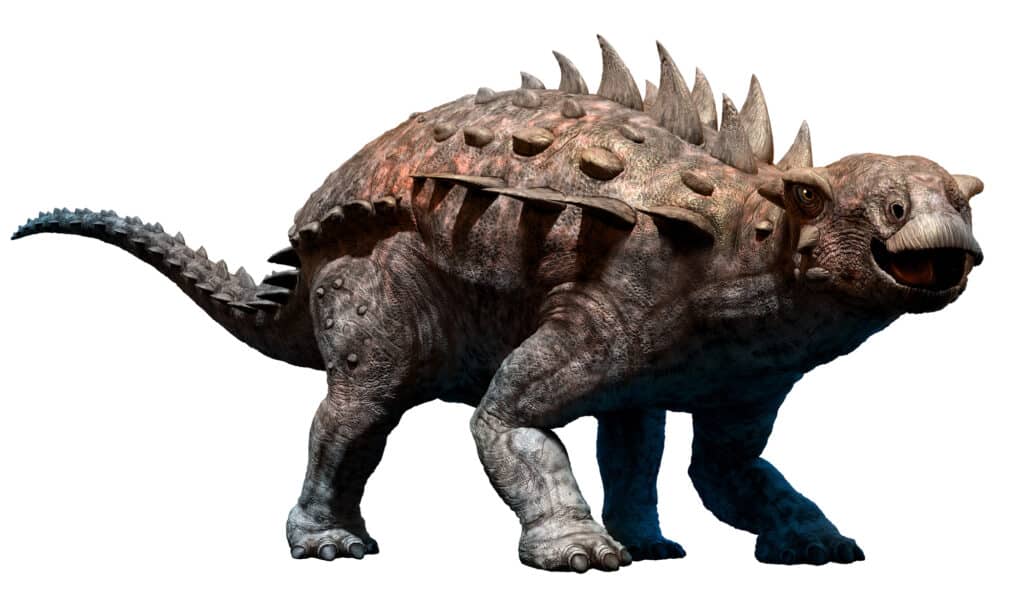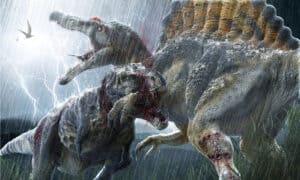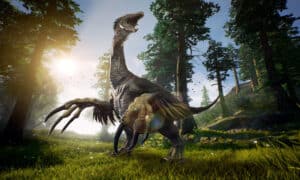While it may not have kidnapped Princess Peach or gone up against Mario, the spiked Polacanthus was the spitting image of the popular video game villain Bowser.
This dinosaur lived during the Early Cretaceous Period. Even though they looked formidable with spikes on their back and armor across their body, the Polacanthus was actually an herbivore. It feasted on plants just like others in the Ankylosauria suborder.
Polacanthus Species, Types, and Scientific Name
Polacanthus refers to an entire genus that includes one species. However, numerous other small fossils may indicate other possible species within the genus. For now, only the type species Polacanthus foxii is categorized scientifically. Numerous specimens have been thought to belong to various species within Polacanthus but the only one that is recognized is Polacanthus foxii.
Polacanthus means “many spines.” It refers to the numerous spikes these dinosaurs had on their hard armor. The second part of the species’ scientific name refers to the researcher who discovered the first specimen. This does not happen often when naming dinosaurs.
This dinosaur is part of the Nodosauridae family and the Ankylosauria suborder. Ankylosaurian dinosaurs were characterized by their hard armor. They were in the Ornithischia order, Chordata phylum, and Animalia kingdom.
Amazingly, Polacanthus has some similarities with modern birds, although distantly. The Ornithischia order refers to dinosaurs with bird-like pelvis shapes. This includes the Polacanthus. The complete taxonomy of this dinosaur is listed below. This shows how it related to other members of the animal kingdom.
Polacanthus
| Kingdom | Animalia | |
| Phylum | Chordata | |
| Order | Ornithischia | |
| Suborder | Ankylosauria | |
| Family | Nodosauridae | |
| Genus | Polacanthus | |
| Species | Polacanthus foxii |
Description and Size
The Polacanthus was around 16 feet long from its head to the end of its tail. This dinosaur walked on four legs and stood around 3 feet tall. It weighed a little over 2 tons and was very dense for its size.
One of the most recognizable characteristics of Polacanthus was its spiked back. In fact, its name Polacanthus actually means “many spines” in Greek. This spiked armor extended from its pelvis, where it had a dense shield, all the way to the dinosaur’s neck. It also went down their tail. The spikes had triangular bases when seen from the side and tapered up to end in a point. The spikes were arranged in rows, although they may not have been perfectly symmetrical.
Not much is known about the Polacanthus’ head because there aren’t any skulls remaining. Dinosaur skulls are notoriously hard to find intact. The holotype specimen, the one used to describe the dinosaur in the most detail, does not contain a skull. Scientists have made their best guesses on what their skull may have looked like using found vertebrae and reconstructions of similar dinosaurs.

The spiked Polacanthus has a remarkable resemblance to Bowser from the Mario video game series from
NIntendo
.
©Warpaint/Shutterstock.com
Diet – What Did Polacanthus Eat?
Because there aren’t any tooth specimens, it is hard to say for sure what Polacanthus ate. But researchers can tell a bit about how they ate based on their overall body structure.
Polacanthus were relatively low to the ground. They didn’t have long necks and couldn’t reach high up to feast on the leaves of tall trees. Instead, they probably foraged for food on the forest floor. They lived in an environment with plenty of conifer plants. They likely ate these as a staple in their diet.
Ankylosaurus was a similar dinosaur that shared many features with Polacanthus, including their armored backs. Its skull was fused and it had a beak, similar to a bird’s. It is possible that Polacanthus shared some of these features and a similar diet.
Habitat – When and Where It lived
Polacanthus lived in present-day England. The first specimen was discovered on the Isle of Wight. The few specimens that can be reliably classified as Polacanthus are from this area.
It lived in the Early Cretaceous Period, between 145 and 100.5 million years ago. Because there are not very many discovered specimens, scientists cannot narrow the window down in which they lived with very much accuracy. They also don’t know exactly when or how these dinosaurs went extinct. There are not any specimens that show they lived close to the end of the Cretaceous Period. This was the point when an asteroid hit the earth, killing all of the dinosaurs and over 75% of earth’s animal species living at the time.
Threats And Predators
Even larger carnivores would have had a difficult time tearing into Polacanthus. Their armor and spikes were an effective shield against would-be predators. These dinosaurs probably did not go after other dinosaurs. Instead, they would have relied on their defense mechanisms to protect them when threatened.
Competition for food, illness and environmental threats would have been a more substantial problem for Polacanthus’ survival. Based on the fossils that have been found, these dinosaurs occupied a relatively small area. They would have been competing with each other for plants. As the earth’s surface changed during the Cretaceous Period, the food source for the Polacanthus also changed.
Young Polacanthus
Polacanthus laid eggs like all other dinosaurs. However, scientists have not discovered any fossilized eggs, clutches, nests, or other evidence. It is likely that these dinosaurs were their most vulnerable while still developing inside their egg and when newly hatched. Many dinosaurs that may not have been able to take on an adult Polacanthus’ armor would have had no problem enjoying their eggs or young as a tasty snack.
Discoveries and Fossils – Where It was Found
The first Polacanthus discovery was made in 1865 by William Fox, a Reverand and paleontologist. He found the specimen on the Isle of Wight. The species was eventually named Polacanthus foxii in his honor. This is unusual in the dinosaur naming world. Names usually refer to specific features or locations where the dinosaurs lived. It is not often that dinosaurs are named after those who discovered them.
The holotype specimen, the one used to officially describe the species, was found in the Wessex Formation. This formation is also on the Isle of Wight. It notably does not include a skull. It does include the pelvic shield and 22 spikes. These were very helpful. to researchers.
Other specimens that may be Polacanthus include single fossilized bones or pieces of armor. It is difficult for scientists to say conclusively that they are actually specimens of Polacanthus. Some maintain that they belong to other species in the genus, but Polacanthus foxii remains the only one described and accepted in the scientific community.
Extinction – When Did It Die Out?
Scientists do not know exactly when the Polacanthus went extinct. The specimens that they were able to find date to the Early Cretaceous, between 145 and 100.5 million years ago. The mass extinction event at the end of the Cretaceous occurred almost 40 million years later. It is possible that Polacanthus lived that late in the Cretaceous.
Changing food sources may have also played a role in Polacanthus’ survival and eventual extinction. They foraged on plants low to the ground. Any changes in this availability, whether from drought, flood, or just the changing surface of the earth, could have disrupted their normal feeding habits.
Similar Animals to The Polacanthus
- Ankylosaurus: One of the most recognizable dinosaurs with armored bodies is the Ankylosaurus. It had similar spikes on its back, a fused skull, and a club at the end of its tail. Ankylosaurus also lived during the Cretaceous, although discovered fossils date to the Late Cretaceous and were found in North America.
- Hoplitosaurus: Another member of the Polacanthinae subfamily, this dinosaur also had armor. Scientists do not know much about this dinosaur due to the poor condition of its fossils found in South Dakota. It is recognized as an independent genus, although researchers did consider including it in the Polacanthus genus at one point.
More Articles You May Like:
The photo featured at the top of this post is © Warpaint/Shutterstock.com
Sources
- Natural History Museum, London, Available here: https://www.nhm.ac.uk/discover/dino-directory/polacanthus.html
- KidAdl, Available here: https://kidadl.com/facts/dinosaurs
- UCMP Berkeley, Available here: https://ucmp.berkeley.edu/mesozoic/cretaceous/cretaceous.php#:~:text=The%20Cretaceous%20is%20defined%20as,the%20dinosaurs%20(except%20birds).
FAQs (Frequently Asked Questions)
When did Polacanthus live?
Polacanthus lived in the Early Cretaceous Period, between 145 and 100.5 million years ago. It is possible that it lived further into the Cretaceous Period but all identified specimens are from the Early Cretaceous.
How big was a Polacanthus?
The Polacanthus was around 16 feet long from its head to the end of its tail and weighed around 2 tons.
Thank you for reading! Have some feedback for us? Contact the AZ Animals editorial team.






